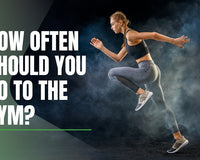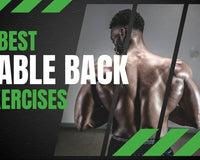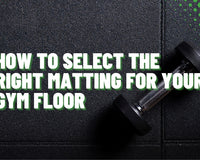When you're pumped to hit the gym, it's tempting to jump straight into your workout. But skipping your warm-up is like trying to start a car on a frosty morning without letting the engine warm up. It might work for a bit, but eventually, you're asking for trouble.
Warming up properly is your secret weapon for safer, more effective lifting sessions. Also it's the perfect time to mentally prepare, shake off the day, and get in the zone.
So, let’s crank up that engine and find out exactly how to warm up before lifting weights.
Why Bother Warming Up?

Skipping warm-ups might save five minutes now, but it could cost you weeks of gym time if you get injured. Warming up increases your body temperature, boosts blood flow, and prepares your joints and muscles for action.
Think of it like stretching a rubber band before pulling it back. It gets more flexible and less likely to snap. Nobody wants to be the person sidelined with a pulled muscle because they thought warm-ups were optional.
Warming up is not just about avoiding injuries because it also improves your overall workout performance. Muscles that are properly warmed up contract more efficiently, and your range of motion increases, allowing you to hit those deep squats or perfect bench presses with ease.
Also, warming up gradually increases your heart rate, making it easier for your body to transition into intense activity without shocking your system.
Related Post: How Much Should You Be Able to Squat?
The Science Behind Warming Up
Your body isn't just getting warm during a warm-up, but rather it's preparing for the heavy lifting ahead.
There are several things that happen when you warm up properly, including the following:
Body Temperature Rises
This helps muscles become more flexible and joints more lubricated. Imagine trying to stretch cold pizza dough versus one that’s had time to warm up.
The warm one stretches and the cold one tears. Warmer muscles can generate force more efficiently and are less prone to injury.

Increased Blood Flow
More oxygen-rich blood flows to your muscles, making them ready to lift, push, and pull without screaming at you halfway through.
Increased blood flow also helps flush out metabolic waste products from previous workouts, meaning your muscles are fresher and ready to perform.
Mental Focus
Warming up gets your head in the game. It's your time to think about your goals, the weights you want to hit, and maybe even the post-gym smoothie you’ll earn.
Visualisation during warm-ups can significantly boost your performance, helping you mentally rehearse each lift and prepare for the challenges ahead.
Injury Prevention
A proper warm-up reduces the risk of injuries. Think of it as body armour made from blood flow and flexibility.
By gradually increasing the intensity of your movements, you allow your muscles, tendons, and ligaments to adapt, reducing the risk of strains, sprains, and tears.
Better Performance
Your joints move more smoothly and your muscles fire up efficiently when you’ve warmed up.
Studies have shown that a well-structured warm-up can enhance strength, speed, and endurance during a workout.
Let’s now talk about the different types of warmups to do before lifting weights.
Dynamic Warm-Ups
Dynamic warm-ups are all about movement. Unlike static stretches that have you holding one position, dynamic stretches get your body moving and blood flowing. Here are some great dynamic warmups for you to do:
Leg Swings

Stand tall and swing one leg forward and backwards, then side to side. It’s like your leg is auditioning for a part in an action movie. Aim for 15 to 20 swings per leg. This improves hip flexibility and prepares your legs for squats, lunges, and deadlifts.
Arm Circles
Stretch your arms out and make circles, starting small and getting bigger. Imagine you’re trying to take off like a helicopter but with more grace.
Perform forward and backward circles for about 30 seconds each. This warms up your shoulders, which are crucial for pressing and pulling exercises.
High Knees
March in place while pulling your knees as high as possible. Bonus points if you pretend you're in a parade. Aim for 30 seconds to 1 minute.
High knees activate your core, hip flexors, and leg muscles, ensuring they’re ready for explosive movements.
Hip Rotations
Stand on one leg and rotate the other hip in big circles. It’s like drawing circles in the air with your knee. Do 10 to 15 rotations on each side.
This improves hip mobility, which is essential for squats, lunges, and deadlifts.
Torso Twists
Stand with feet shoulder-width apart and twist your torso side to side. You’ll look like you're practising for a 90s dance party, but it works. Perform 20 twists to loosen up your spine and core.
With dynamic stretching out of the way, let’s get that cardiovascular system fired up.
Cardio Warm-Up
A light cardio session helps increase your heart rate and blood circulation. It wakes up your body, gets your blood flowing, and lets your muscles know it’s time to put in some work.
Here are some easy options that will have you ready to lift in no time:
Jogging

Hit the treadmill or jog in place for five minutes. A steady jog gradually raises your heart rate and loosens up your legs, making it a great way to ease into your session without feeling winded right away.
Jumping Jacks
Channel your inner kid and get those arms and legs moving. This full-body movement quickly increases your heart rate while also warming up your shoulders, core, and legs.
Cycling
Hop on a stationary bike for a quick spin. No, you don’t need to pretend you’re in the Tour de France, but a steady pedal session strengthens your legs and improves endurance, giving you a solid cardio start.
Cardio warm-ups help you break a light sweat, signalling your body that it’s time to get serious.
They also prepare your cardiovascular system for the demands of weightlifting, ensuring that your heart and lungs are ready to support your muscles during intense efforts. Plus, you’ll avoid feeling sluggish when it’s time to lift.
However, when lifting weights, you don’t just need your blood pumping, but also your muscles activated and ready to lift.

Specific Muscle Activation
Before you start lifting heavy weights, you’ll want to target the specific muscles you’ll be using during your workout. Here are some great examples of warmups for specific muscle activation.
Related Post: Are Deadlifts a Back or Leg Exercise?
Glute Bridges
Lie on your back, lift your hips, and squeeze your glutes. Pretend you're pushing off the floor like it owes you money. This move fires up your glutes, which are essential for squats, deadlifts, and lunges.
Shoulder Rotations
Roll your shoulders forward and backward. It’s like shrugging but with purpose. This simple movement gets your shoulders loose and ready for pressing exercises, whether it's bench presses, shoulder presses, or rows.

Bodyweight Squats
Do a few squats without weights to get your legs ready for action. They help open up your hips, engage your quads and hamstrings, and make sure your lower body is primed for heavier lifts.
Push-Ups
Warm up your chest and triceps with a few push-ups. It’s the perfect primer for upper-body days, activating your chest, shoulders, and arms all at once.
Planks
Get that core engaged by holding a plank. Imagine you're a human table and don’t let the imaginary drinks spill. A strong core supports every lift, from deadlifts to overhead presses.
For example, if you’re planning to do heavy squats, include bodyweight squats, lunges, and hip openers in your warm-up. If it’s a bench press day, focus on push-ups, shoulder rotations, and band pull-aparts to ensure those muscles are awake and ready.
Muscles are of course important to warm up for lifting weights, but so are your joints, so let’s do that next.
Related Post: Smith Machine Vs Squat Rack - Which One to Choose?
Mobility Drills
Mobility drills improve your range of motion, which is crucial when lifting weights. Your joints will thank you later, and your lifts will feel smoother than ever. Mobility work ensures that every squat, press, and pull happens without stiffness holding you back.
Here are some examples of mobility drills to get those joints warmed up:
Hip Circles
Rotate your hips to improve mobility. It’s like slow-motion hula-hooping, minus the embarrassing memories from gym class. This movement helps loosen up your hip joints, making squats, lunges, and deadlifts more comfortable and effective.

Wrist Circles
Move your wrists in circles. This is perfect prep for any grip-heavy exercises like deadlifts, rows, and bench presses. Strong, mobile wrists mean fewer chances of discomfort or injury when you’re holding heavy weights.
Ankle Rolls
Rotate your ankles to get them ready for squats. Tight ankles can mess with your squat depth and balance, so give them the attention they deserve before loading up the barbell.
Neck Rolls
Gently roll your neck to avoid any tension. You don’t want to be that person rubbing their neck after every set. Loose neck muscles help with posture and stability during overhead lifts and bench presses.
Incorporating resistance bands into your mobility drills can add an extra challenge and improve flexibility further.
For example, banded hip openers can enhance your squat depth, and banded shoulder dislocates can improve shoulder mobility for pressing exercises.
Adding foam rolling before or after mobility drills can also help release muscle tightness, making your warm-up even more effective.
Below, we’ve put together a sample warmup routine to help get you started.

Sample Warm-Up Routine
Here’s a simple, effective warm-up routine to get you gym-ready:
-
3 Minutes of Cardio: Jog, cycle, or do jumping jacks.
-
3 Minutes of Dynamic Stretches: Arm circles, leg swings, and high knees.
-
2 Minutes of Muscle Activation: Push-ups, glute bridges, and squats.
-
2 Minutes of Mobility Drills: Hip circles, wrist rolls, and neck rolls.
Modify this routine based on your workout. For a lower body day, add more hip and ankle mobility drills. For an upper body day, include extra shoulder and wrist stretches.
All of that being said, what about that boring static stretching you see everyone doing?
What About Static Stretching?

Save static stretching for after your workout. Stretching cold muscles is like pulling a frozen rubber band. It’s less than ideal. However, post-lift, static stretches help with flexibility and recovery.
Your future self will thank you when you’re not walking like a robot the next day.
Include stretches like the seated hamstring stretch, chest stretch, and hip flexor stretch post-workout to help release muscle tension and improve flexibility.
Final Thoughts on Warming Up Before Lifting
Warming up might seem like a chore, but it’s the key to safer, stronger workouts.
So next time you hit the gym, spend those extra minutes warming up. Your body, your performance, and your future gains will be all the better for it.
You might not think you need it, but once it’s on, you can’t imagine lifting without it.





